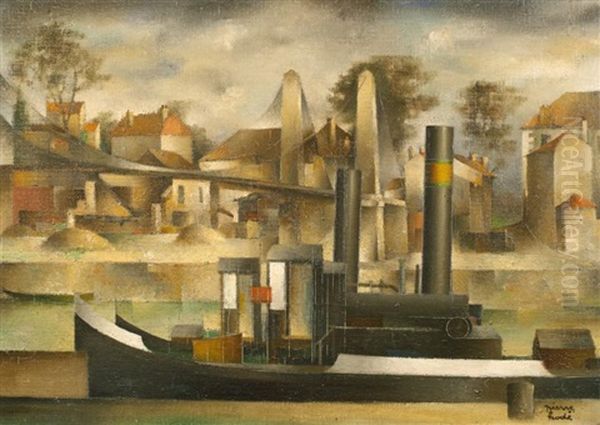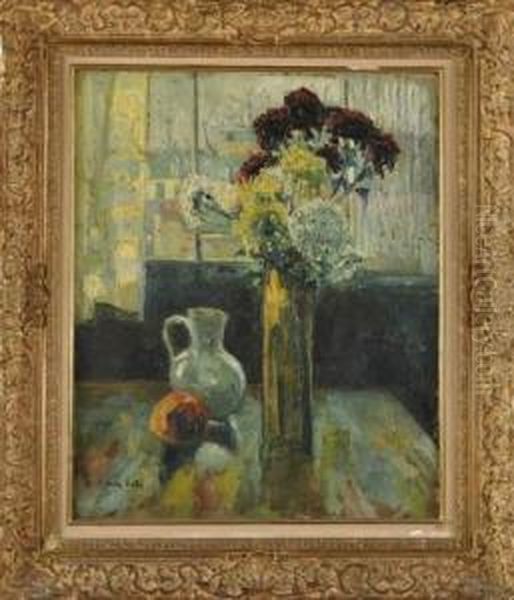Pierre Hode stands as an intriguing figure in early 20th-century French art. Born in 1889 and passing away in 1942, his life spanned a period of radical artistic transformation in Europe. Primarily recognized as a painter associated with Cubism and the regional École de Rouen (Rouen School), Hode carved out a distinct path, blending influences from the Parisian avant-garde with his Norman roots. Though perhaps less globally renowned than some of his contemporaries, his work offers valuable insights into the diffusion and personal interpretation of Cubist principles.
Early Life and Artistic Awakening in Normandy
Pierre Hode's story begins in Normandy, France, the region of his birth in 1889. Details about his specific birthplace within Normandy are sometimes generalized, but the region's landscape and artistic heritage undoubtedly shaped his initial outlook. Unlike many artists who followed a traditional academic path, Hode was largely self-taught. His innate talent for drawing and painting emerged early; sources suggest he began painting seriously around the age of fourteen.
His initial artistic explorations were rooted in the styles prevalent at the turn of the century. He absorbed the lessons of Post-Impressionism, likely studying the works of artists who had famously captured the Norman coasts and countryside, such as Claude Monet or perhaps regional figures associated with the burgeoning Rouen School. There are also indications that the bold colors and expressive forms of Fauvism made an impact on his early development, a common trajectory for artists of his generation seeking alternatives to Impressionism's focus on light and atmosphere. This period laid the groundwork for his later, more radical engagement with form and structure.
Arrival in Paris: The Crucible of the Bateau-Lavoir
A pivotal moment in Hode's career was his move to Paris, the undisputed center of the art world at the time. He found himself drawn to Montmartre and specifically to the legendary Bateau-Lavoir. This dilapidated complex of studios was more than just affordable housing; it was a melting pot of creativity, a nerve center for the burgeoning avant-garde. Residing and working there placed Hode directly into the orbit of some of the most revolutionary artists of the era.

Most significantly, the Bateau-Lavoir was famously home to Pablo Picasso and Juan Gris, two towering figures of Cubism. Hode lived and worked alongside these masters, absorbing the radical ideas being forged around him. The environment was one of intense discussion, experimentation, and mutual influence. Other notable figures frequenting the Bateau-Lavoir during this period included Georges Braque, the co-founder of Cubism with Picasso, the poet and art critic Guillaume Apollinaire, a key champion of the movement, and figures like Max Jacob. This immersion in the intellectual and artistic ferment of the Bateau-Lavoir was crucial in Hode's transition towards Cubism.
Embracing Cubism: Analytical and Synthetic Explorations
Influenced profoundly by his experiences at the Bateau-Lavoir and the groundbreaking work of Picasso and Gris, Pierre Hode embraced Cubism. His work reflects an engagement with both phases of the movement's early development: Analytical and Synthetic Cubism. He didn't simply mimic his more famous peers; instead, he synthesized their innovations into his own distinct visual language.
His paintings often feature the geometric fragmentation characteristic of Analytical Cubism, where objects are broken down into facets and viewed from multiple perspectives simultaneously. However, he also incorporated elements associated with Synthetic Cubism. This later phase, pioneered by Picasso, Braque, and Gris, involved building up images from simpler, flatter shapes, often incorporating collage elements or textures suggestive of real-world materials. Hode's work frequently includes motifs common in Synthetic Cubist still lifes: musical instruments, bottles, glasses, and fragments of newspapers or magazines, assembled into complex but coherent compositions.
Hode's interpretation often retained a stronger connection to representational reality than the most abstract works of his contemporaries. He focused on dissecting and reconstructing the essential forms of objects, simplifying them while maintaining their recognizability. His palette could vary, sometimes employing the muted tones of early Cubism, other times utilizing brighter colors more aligned with Synthetic Cubism or the influence of artists like Robert Delaunay.
The École de Rouen Connection
While deeply involved in the Parisian avant-garde, Pierre Hode maintained connections to his native Normandy and is associated with the École de Rouen. This "school" wasn't a formal institution but rather a loose grouping of artists connected to the city of Rouen, active from the late 19th century through the early 20th century. Initially dominated by Impressionist and Post-Impressionist painters capturing local scenes, the group later included artists embracing more modern styles.

Notable figures associated with the École de Rouen include Albert Lebourg, Robert Antoine Pinchon, and, significantly, Raoul Dufy, who himself transitioned from Fauvism towards a unique, decorative style influenced by Cubism. Hode's connection likely stemmed from his Norman origins and perhaps participation in regional exhibitions, such as those organized by the Société Normande de Peinture Moderne. His work Rue de Rouen (Rouen Street), known from auction records, directly references this regional tie. His association highlights the interplay between the Parisian center and regional artistic developments in France during this period.
Key Works and Stylistic Hallmarks
Several specific works help illuminate Pierre Hode's artistic style and concerns. Le Siphon, Verre et Journal (The Siphon, Glass and Newspaper) is a prime example of his engagement with Synthetic Cubism. This painting, held in the collection of the Museum Ostwall in Dortmund, Germany, features characteristic still-life objects rendered through flattened shapes, overlapping planes, and a focus on structure. The inclusion of text elements, suggested by the newspaper, is a hallmark of the Synthetic phase.
Another significant work is Les Remorqueurs (The Tugboats) from 1923. This painting demonstrates Hode's ability to apply Cubist principles to subjects beyond still life. Depicting boats in a harbor, the composition is built upon a strong geometric framework, contrasting the vertical lines of masts and structures with the horizontal lines of the water and docks. The forms are simplified and angular, yet the scene remains identifiable, showcasing his blend of abstraction and representation.
Works like Le bal du 14 Juillet à la Tour Eiffel (Bastille Day Ball at the Eiffel Tower) (1923) and Bouquet de fleurs (Bouquet of Flowers) (1923) further illustrate his approach during the early 1920s. These pieces likely demonstrate his handling of color and complex compositions, applying Cubist fragmentation and structuring to dynamic scenes or traditional subjects, imbued with a personal sense of rhythm and design. His treatment of subjects often involved stripping away extraneous detail to focus on the essential underlying forms and their interplay within the pictorial space.
Artistic Evolution: Three Phases
Art historians often describe Hode's career as evolving through three distinct phases, reflecting his journey through the major artistic currents of his time.
The first phase was marked by his early explorations, heavily influenced by Post-Impressionism and the landscape painting traditions of Normandy, likely incorporating elements of Fauvism's bold color and expressive brushwork. This period established his foundational skills and connection to depicting the visible world.

The second phase represents the core of his artistic identity: his deep engagement with Cubism. This was the period of his immersion in the Bateau-Lavoir milieu, his close observation of Picasso and Gris, and his development of a personal Cubist syntax combining analytical deconstruction with synthetic reconstruction. Geometric forms and the structuring of space became paramount.
The third phase, particularly evident in his later work, saw a move towards a more refined, perhaps simplified, synthetic style. This involved a further distillation of forms, focusing on the essential elements of reality while maintaining a certain clarity and "discreteness," as some sources describe it. He continued to explore composition and structure but perhaps with a greater emphasis on harmony and essential representation, moving away from the more complex fragmentation of his earlier Cubist works. This phase also saw his involvement in decorative arts and stage design, broadening his artistic output.
Interactions and Influences: A Network of Artists
Pierre Hode's artistic development was shaped not only by the giants of Cubism but also by a broader network of contemporary artists. His documented participation in a 1912 exhibition organized by the Société Normande de Peinture Moderne places him alongside Robert de La Frenaye, Jacques Villon, and Raoul Dufy. This event underscores his position within a circle of artists exploring modernism outside the strictest confines of the Picasso-Braque partnership.
Robert de La Frenaye was another artist who developed a unique take on Cubism, often featuring dynamic, large-scale compositions. Jacques Villon (Gaston Duchamp), brother of Marcel Duchamp and Raymond Duchamp-Villon, was a key figure in the Puteaux Group (or Section d'Or), which promoted a more mathematically inclined and sometimes more colorful version of Cubism than that of the Montmartre pioneers. Other members of this circle included Albert Gleizes and Jean Metzinger, who co-authored the first major treatise on Cubism, "Du Cubisme" (1912). Hode's interaction with these figures, even if only through exhibitions, situated him within the wider discourse of Cubist exploration.
The influence of Robert Delaunay, known for his vibrant Orphism (or Simultanism), is also noted in some descriptions of Hode's work, potentially explaining references to a "naturalistic style" or a particular sensitivity to color harmonies alongside Cubist structure. Hode navigated these various influences, creating a body of work that reflects the diverse currents within Parisian modernism.
Later Career, Recognition, and Legacy
Following the upheavals of World War I, Hode continued his artistic practice, dividing his time between Paris and Normandy. He maintained his focus on painting but also branched out into applied arts, creating designs for the stage and decorative panels. This diversification was not uncommon for artists of the period, seeking different avenues for expression and income.
While he may not have achieved the widespread fame of Picasso, Braque, or Léger, Hode gained recognition within certain circles. He was described as a demanding painter, preferring to work with discerning collectors who understood his artistic aims. His works appeared in exhibitions and gradually entered public and private collections. The auction estimate mentioned for Rue de Rouen (€2000-€3000 at the time of the source) provides a small snapshot of his market presence, suggesting a respected but perhaps not top-tier valuation compared to the movement's leaders.
Pierre Hode's legacy lies in his dedicated exploration of Cubism from a personal perspective. He represents the significant group of artists who absorbed the revolutionary breakthroughs of the early 20th century and adapted them into individual styles. His connection to both the intense environment of the Bateau-Lavoir and the regional context of the École de Rouen makes him a fascinating case study in the dynamics of French modern art. His work stands as a testament to the enduring power of Cubism's formal language and its capacity for varied interpretation.
Conclusion: A Distinct Voice in French Modernism
Pierre Hode remains a noteworthy French painter of the first half of the 20th century. A self-taught artist deeply influenced by his time at the Bateau-Lavoir alongside Picasso and Gris, he forged a personal style rooted in Cubism. His work skillfully blends the analytical breakdown of forms with the synthetic reconstruction of reality, often focusing on still lifes and scenes imbued with geometric structure. Associated with the École de Rouen yet fully engaged with the Parisian avant-garde, Hode navigated the complex artistic landscape of his time, leaving behind a body of work that reflects both the major innovations of modernism and a distinct individual sensibility. His paintings continue to be appreciated for their structural integrity, thoughtful composition, and unique place within the broader narrative of Cubist art.